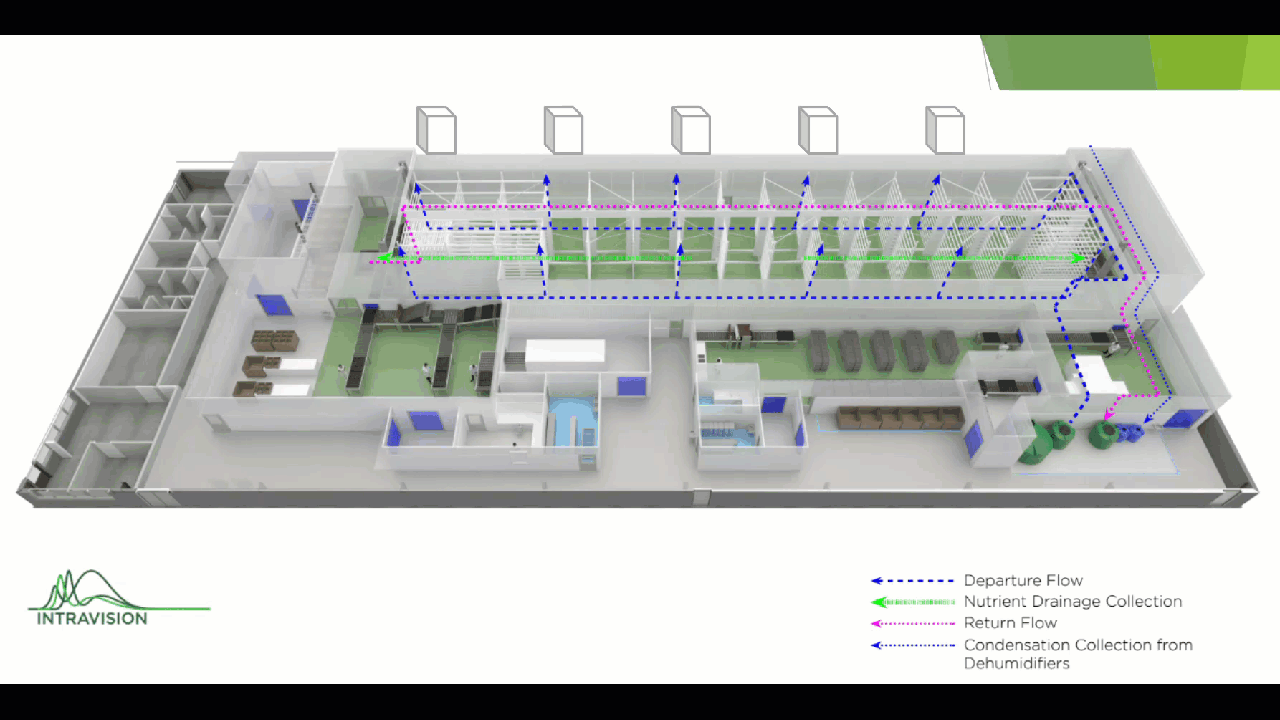Bluelab's Future of Controlled Agriculture webinar series brings the best minds in CEA together to discuss the frontier of horticulture. Our host, Caroline Nordahl, Chief Sales and Marketing Officer here at Bluelab, talks with plant scientists, top CEA researchers, and engineers for a unique lens on what we can expect in the future of CEA.
In this webinar episode, we talked with Dr. Matt Mickens, Chief Science Officer of Elevate Farms and Derek Smith, Executive Director of the Resource Innovation Institute about how indoor farming operations can grow more crops with less water and energy.
Download the full conversation here, but otherwise, read on for the key takeaways.
Key takeaways
To bring costs down, measure and aim to reduce water and energy use
Growers today are facing the daily issue of climate risk, as well as trying to figure out how to adopt technology to grow more productively and efficiently—all while maintaining excellent crop quality.
When it comes to Controlled Environment Agriculture (CEA), opting for vertical farming brings the benefits of water conservation, no pesticides, the ability for traceability, and energy efficiencies.
CEA isn't without its challenges, of course. Arguably, the biggest challenge in CEA is reducing energy costs, so Matt's immediate focus is on improving the efficiency of Elevate Farm's energy and water usage.

“We’re all trying to figure out how much energy is being used in these indoor cultivation environments, how is that energy being used, how efficiently is it being used and what are the KPIs to measure efficiency”
— Dr. Matt Mickens, Chief Science Officer of Elevate Farms
How Elevate Farms saves 97% more water than traditional farmers in the Southwest US
Most traditional farmers in the Southwest US use 250 litres (66 gallons) of water per kilogram of produce per year. Elevate Farms uses just 8 litres (2 gallons) per kilogram per year, with the goal of bringing it down to just 6kg (1.5 gallons) per year. With droughts becoming more severe, there is an increasing appetite to reduce water usage to preserve food security.
The secret lies in their closed water system. Their gravity-fed NFT (nutrient film technique) brings nutrient water over and irrigates layers of crops on a pre-programmed schedule. The water is then drained and filtered back through the nutrient system. 90-95 percent of the water uptake of the plant is transpired through evapotranspiration, and that water can be re-captured through dehumidification. This water is then treated, filtered and brought back as top-up water for nutrients.

Using closed-loop water and air technology, 36 million litres (9.5 million gallons) of water is saved annually. This method is scalable—using 3 percent of the water needed when compared to traditional farming, with no compromise on a nutrient-rich end product.
Light intensity—a vital metric to review for energy saving
LED lighting in controlled environments tends to grow crops really fast. Therefore, Matt and Derek highly recommend measuring light intensity to ensure your plants are not getting too much, or too little light, which will directly affect yields and energy consumption.

The bar chart above displays real data from the power score from facilities, using different light solutions. Farms with LED displays are not only improving their energy savings (kilowatt-hours), but also see an 80 percent productivity increase per unit of electricity consumed.
In addition to light intensity, both Matt and Derek reinforce that oxygen content and pathogens in water are other key metrics to analyse for optimal growth.

“We’ve got KPIs on energy, emissions, water and waste. We’re working every day with producers, governments and utilities to establish benchmarks and baselines to help people adopt the most efficient practices. That’s through facilitating best practices, developing standards, training the market, supporting policy, development and supporting the utility program development”
— Derek Smith, Executive Director of the Resource Innovation Institute
How automation and efficiency-based design transforms CEA
Matt confirms that automation in their CEA practices has been the key to Elevate Farm's success.
The positives of automation:
- The algorithms determining the perfect growing conditions for a wide range of high-nutrient crops
- Data is continuously monitored and analysed through the growth cycle
- Lighting and climate adjustments are automatic
- Within 20-30 days, plants are transferred robotically to the harvest area
- Knowing exactly when plants are going to hit exponential from multi seedling trials and testing with planting dates for optimal results
The challenges of automation:
- Determining when and where to automate processes
- Tackling energy costs
- Having the right people onboard
- Having trained staff with a genuine instinct to communicate with data teams
- Constant benchmarking
We can achieve local food security at a global scale
Elevate Farm’s mission statement is Local Food Security on a Global Scale.
Their automated facility in Welland, Ontario is pioneering new technology in CEA, pushing the limits of what's possible in food production.
%20(1)-png.png)
Their grow tunnel system, (shown above) provides capability and control of the environment which is separate from the warehouse. This was purpose-built from the ground up—using only 5000 square feet, leaving the remainder of the warehouse for other processing activity.
How grow tunnels enable local food on a global scale
- Has the ability to grow 450,000 kilograms (992,080 pounds) of leafy greens per year in any climate
- Artificial intelligence-driven light recipes determined custom size, flavour and nutrient values
- Minimise space required
- Provide a controlled environment that has a high density of plants and a small growing area
- Each facility can grow up to 18 layers of leafy greens
- Fully scalable with minimal human intervention
Data plays a vital role in energy reduction
To help producers make decisions when growing and move toward more efficient production models, data reporting, metrics and facility benchmarking are required.
Facility benchmarking is relevant and relative to all commercial buildings. However, comparing that understanding to what other buildings are doing helps business owners or occupants find energy savings—which is one challenge with vertical farming.
“That path to efficiency, productivity and profitability really starts with benchmarking and tracking performance. If you want to know how efficient you are, if you want to compare your performance to other operations, that is what we’re here for.”
— Derek Smith
The Resource Innovative Institution is assisting producers with figuring out how competitive your facility is among the CEA market. A building rating system will help verify performance toward efficiency and productivity.
You can validate your year-over-year performance using the Resource Innovation Institute's free validation tool.
"By benchmarking a lot of facilities and bringing in confidential data, we are able to build a dataset that is able to form KPIs and benchmarks by crop, by region and by climate zone to help us guide that path toward more efficiency.”
— Derek Smith
Measure, verify and report so you can:
- Understand what is happening with crops over the course of a harvest cycle, or annual production cycle
- Gather insight on what the facility with the use of resources relative to production amount
- Predict what the yields are
- Predict optimal time to harvest
Standardise and share the data so we can all make better decisions
How do we verify CEA is the resilient future we all want? Derek believes there are a lot of claims on environmental and social benefits, however, what’s important to focus on is governance which heavily relies on data. This is why data needs to be standardised, validated, comparable and trusted.
“What I want to convey is everybody is really interested in ESG right now and that's great and there's access to new capital. There’s a lot of investors that are interested in including some of those that are shown here, who is on our advisory council.”
—Derek Smith
Good questions to ask for standardised data in CEA include:
- How is my operation performing year over year?
- How does performance compare to other farms?
- Is that information resident in that facility
- Is that information verifiable?
- Is it comparable to other farms?
Proven methodologies, natural resource efficiencies and connecting tech to growing environments shape the future of commercial cultivation, without compromising on fresh and nutritious products.
Both Matt and Derek share the same sentiment; that through collaboration, data and transparency, we have the ability to grow more food with fewer resources.
Download the full webinar on-demand by clicking the image below.



%20(1).png?height=100&name=Blog%20Author%20Bio%20Image%20500x500%20(2)%20(1).png)
-jpg.jpeg)
Submit a comment